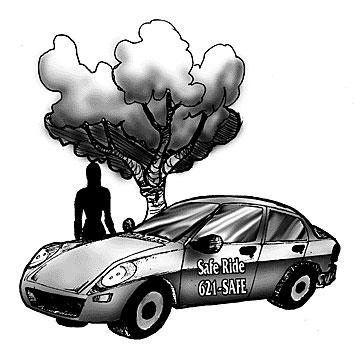
Illustration by Arnie Bermudez
|
|
By Jason Poreda
Arizona Daily Wildcat
Monday November 10, 2003
Last week, SafeRide, the program that ASUA sponsors for students working or studying on campus, changed its policy as to who really needs a safe ride.
Now, in order to use the program, you either have to be alone or with one friend. Groups of three or more will no longer be eligible to call up for a free ride.
It's about time.
Over the past few years, more and more students have been using the service out of laziness, just wanting a ride ÷ usually just around the corner ÷ or wanting a ride to or from a party.
Last year I volunteered for the service and I can vouch for this. I made a number of pickups in which I drove a large group from the Coronado Residence Hall to the Student Union Memorial Center or some other easily walkable distance.
The whole purpose of the SafeRide program is to offer rides to people who don't feel safe walking in the area around campus at night.
It is not a taxi service, which is something most students have seemed to forget in criticizing this new policy.
In last Wednesday's Wildcat, several students were quoted as saying that the new policy is not a good idea and that groups of three aren't necessarily safe.
You could also say that a group of 15 isn't safe ÷ a terrorist could hold them captive, they could be hit by a runaway bus or something else ÷ but I'm sure that nobody could argue with the fact that groups are definitely safer than one person ÷ a lot safer.
Beyond this question of who or how many people are safe walking around campus, there are several other reasons why this policy will provide a huge lift for a program that is constantly fighting budget problems by helping greatly with the day-to-day operations of the program.
Only picking up one or two people will go a long way to make the service run more efficiently and effectively.
I wanted to see how the new policy was working and if it was having the effect that Director Joshua Wright wanted, so I tagged along with SafeRide driver John Malek-Ahmadi to see for myself.
It didn't take long to see that the new policy was having a positive effect, both in terms of response time and the number of pickups John and I were able to make in the relatively short time I was in the car. "The new policy helps us out a lot; we can make a lot more pickups," Malek-Ahmadi said.
We started talking about what picking up a big group does to the drivers and we agreed the biggest problem is that it fills the car until they are dropped off.
Other people who call in for a ride have to wait a long time before the car is empty and able to get them.
Now that SafeRide is only giving rides to small groups, more "pickups" can fit in each car, making wait times go way down.
"About a week before the policy went into effect, I gave a ride to three girls from the corner of Mountain and Speedway to Coconino," Malek-Ahmadi said.
"Other people had to wait until I was done with that one pickup," he said when asked if many people still use the service more out of laziness than out of safety concerns.
Only picking up one or two people will deter the vast majority of students from abusing the service.
During the time I was in the car, it was evident that fewer people were calling in for "lazy" rides.
It's good to see one of the best programs we have on campus trying to get better and refocus.
The new policy that SafeRide has enacted is clearly having a positive effect for the program itself and the students using it to get home.
- Jason Poreda is a political science and communication senior. He can be reached at letters@wildcat.arizona.edu.
